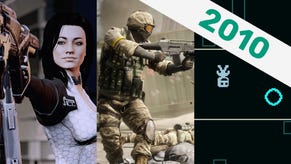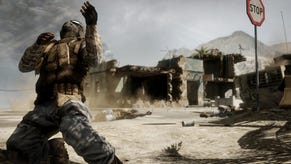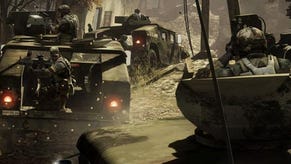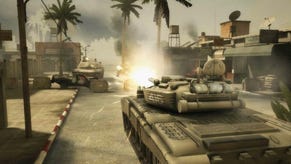Battefield: Conquest vs Rush vs Issues
So, Plans A & B may have failed. That leaves us Plan C. That's the one where I stop using broad strokes to paint a picture of Battlefield: Bad Company 2 for you, and whip out the single horsehair brush to start filling in all the minor details. This is where the highlights and lowlights are done, chaps.
Unsurprisingly, the new Battlefield game is doing rather well with fans of the series. It's providing similar thrills we've found before, on a slightly smaller scale, but with far more attention to detail. We've got destructible environments, prettier landscapes to kill each other over, and an EA Server system that lets each little bit of contribution to your side get logged and added to the overall tally system of unlocks. This is roughly the third iteration of Battlefield (so long as you ignore stuff like Battlefield Vietnam, or Battlefield 2142, or Battlefield 1943. Oh alright, it's Battlefield Mk 6, although it's not Battlefield 3, that's still to come.)
Let me break it down for you. This is the breakdown, broken down into bits of broken words:
There are two game modes, and the first of these is Conquest. This is typical Battlefield; you fight over a set number of control points, each a distinct area, and sometimes a front line forms around the ones that were closest to your base at the start, the ones closest to the enemy, and the one, maybe two, that sit in the grey, mostly bombed out area in between. It's an interesting process because while there may be a natural line formed between the two sides, it allows for flanking, sneaking, conniving and hero antics where you manage to break through and steal their safest point right from under their noses. The maps also tend to be more square because of this, enabling lots of movement both forward and side to side, like a car in an empty car park.
The problems arise in the unfocused nature of drop-in server Conquest games. Because any point can be captured, and does get captured, it's pretty easy for a match to turn into one large game of tag, with you chasing down a rogue squad in your base that's moving from point to point capping each one before moving on. You don't know where they're going to strike next, you can't pre-empt them, and you can't cover all your bases because they're too large to take out.
The second mode is Rush. This is for the more military-minded players. And pretty much everyone else, really. Basically you've got a defender team, and an attacker team. The defenders must defend a pair of M-COM (yeah, I don't know what they are either) stations from being bombed/shot/collapsed on by the enemy, which involves a frenetic, if static, mode of play that relies on you working with your team to set up a defensible position, call out targets and generally not just doing your own thing. If you do you'll be a) dead and b) unable to serve as a human shield for your team. Which they need, otherwise they'll also be a).

The attackers are the shrapnel Ying to the Defender's Kevlar Yang. As the defenders attempt to protect the thingy stations, the Attackers make attempts to destroy it. It's a simple concept, but when you factor in that some maps have tanks, which can destroy the very buildings that protect the stations, thus obliterating them, you can't just hide in the building waiting for some unfortunate to come bursting through the door. Defence, therefore, is proactive. You must HOLD THE LINE. You've also got stuff like secret mountain paths, soaring Black Hawk helicopters, sneaky UAV drones, speedy quad bikes, assaulterific Humvees, and lots of different people doing lots of different things. Rush becomes quickly becomes a kind of deathmatch sprint in which you push a trail of devastation through the map.
It's by far my preferable play-mode, but it isn't without its drawbacks. While solving all of Conquest's problems of an unfocused play-style, Rush has the opposite problem of not offering nearly as much potential hijinks. The objectives are very clear, and because of that there isn't a huge deal of room for improvisation. In Rush your job is very clear. Deviate and you doom the team. Rush - to return to the previous analogy - is a car on a country lane; unable to turn or do anything but follow the poorly maintained tarmac and throw up a lot of dirt as it rips along the road.
Oh and there is a squad deathmatch mode, and we don't talk about deathmatch modes. (Because we haven't played them.)
OK, so that covers the many different ways you can play the game. The many two ways. Basically, this is a typical Battlefield game but with a few improvements that serve to focus the conflict and create the tense, edge-of-your-seat sort of stuff that you've come to expect. Also: the flattening of the buildings.
And now for some other issues.
The Browser: I've not really seen a browser this bad in... I actually can't remember the last time I've seen a server browser this bad. It's slow. I've got into the habit of minimising the game and browsing a few news stories online while I wait for it to pick up the server information. Admittedly, one of the recent patches removed the game's annoying presumption to immediately start searching for servers as soon as you started the server browser (that might sound a little counter-intuitive, but the game doesn't provide you with the ability to save preferences, so you'll want to uncheck 'full games' and 'empty games' before searching, just so you're not wasting your time.) Even then, quite often it'll just come back with the message 'Unable to login to EA Servers', despite the fact that you are logged in.
Hell, I'll throw this under this heading too; the friends system is a bit of a shambles, too. Quite often it won't even register that a friend you're trying to add exists, let alone allow you to add them. Then, once you have added them, it might not bother sending that request to them, and so you'll think you've added them when you haven't. More than once I've ended up getting said friend on chat so I can check that it's gone through after multiple failed attempts. It's not good.
40mm Grenades: This one might come across a little whiny, but bear with me. So the assault class starts with an underslung grenade launcher on his assault rifle. It fires 40mm grenades, that have a small, but powerful blast with whatever they hit. They're great for taking out walls, or blowing up that encampment of snipers hiding behind a dumpster or whatever. The problems arise when the grenade has two major boosts to its effectiveness. Firstly, it kills on impact. Secondly, you get two of them on spawn, and your ammo box can provide you with more indefinitely.
That might sound fine, but when an underslung weapon, which is effectively your alt fire, is more effective than your primary, something is wrong. In BF: BC2 you get stars when you achieve a certain amount of kills with a weapon. First you get Bronze, then Silver, then Gold, then after ten golds, you get platinum. I think they're at increments of 50, 100, 200, 300, and so on. I've seen a few people with gold stars, but they're the dedicated hard core. I've only got a few silvers, and that's on the guns I've been using since the beginning of the game.
Nearly every time I'm killed by a 40mm grenade (roughly 30% of my deaths are from this airbourne bastard) the killer has at least two or three golds. I've seen a few platinums, and to add insult to injury, most of them have a set of perks that a) increase the power of their grenades, meaning even if they miss, they don't miss, and b) increase the number of grenades they can hold. They're turning themselves from useful members of their team to grenade lobbing dicks.
And that's why I hate the 40mm grenade.

The M60: Something's gone wrong when a medic has the most powerful gun in the game, powerful and accurate enough to rival the sniper rifles, while being fully automatic. If the 40mm grenade kills me 33.3% of the time, the M60 takes up another 33.3%.
Team Imbalance: Battlefield: Bad Company 2 has a team balance system automatically in it, and most servers are running it. The only real problem with this system is that it does nothing. At all.
I'm not entirely sure where it goes wrong, but it might well have something to do with the fact that when you join a game through your friends list, you automatically join their team. With BF:BC2 being a highly social game, most people are trying to play with friends. And so you get ridiculous situations where you can have 5 people on one team and 27 on the other. Yes, that's happened.
The whole problem is compounded by a system in place to stop people switching to the winning team all over the place. If you manually switch team, you're not allowed to do it again for a good ten or fifteen minutes. This ordinarily wouldn't be an issue, but it looks like the game does a team switch when you join server. So you join, see the teams are woefully unbalanced, and attempt to switch, only to be told you can't.
Those are the main problems. And they wanted to make you play, right? No? Then how about some of the many, many things that BF:BC2 does right. Here's the highlights to the previous lowlights. This is going to be like an oscillator, with some kind of awesome retro display.
The Awesome:
Explosions: They're so very versatile. And hot. And boom! etc. Explosions are the glue that sticks together all that is great about BF:BC2. Or maybe they're the can opener that opens the awesome stack of features the Frostbite engine brings to the latest installment. Whatever supplementary tool they are, they're great, because they blow stuff up. The the blowing stuff up in BF:BC2 is the best blowing stuff up I've yet seen. Because stuff actually blows the hell up. Walls explode outwards, buildings collapse, tanks erupt into hollow husks that used to be tanks, slowly smouldering in the middle of the battlefield. Also, the after effects of the explosions are almost as good as that instant jubilation of seeing something explode. Pieces of whatever you just blew up scatter all over the place, sometimes killing those nearby, and a huge cloud of dust the colour of whatever you blew up stays in the air for a few seconds, making whoever you blew up but didn't kill have to choke and not see. Which is basically the next best thing to blowing someone up. Oh, and you probably deafened them too.
Team Play: I drew comparisons to Team Fortress 2 in the last piece, and they were completely deserved. Bad Company 2 manages to incentivise team play in such a way that you play with your team because you're selfish. Because helping your team gives you delicious points that all add up and increase your score with that class and then you get goodies to play with and then you get to get more points which get you more goodies and... oh you get the point. Basically, if you heal team mates and revive people as a medic, you'll get more points than if you tried to just shoot people as medic. Which is a great way to turn selfish players into contributors.

The Sound: God, it's incredible. It's almost a shame that so much of it is going on at once. I want to be able to clearly hear the sound my rifle makes when I squeeze off a shot, but I've got so much gunfire and explosions around me that it just adds to the cacophony. The sound warps depending on location, too, so if you're inside a house your gun will have more bass to it, due to the acoustics. Man, I just got to talk about acoustics in a game, that's got to be worth something.
The Maps: I've heard these be slammed elsewhere, but really the multiplayer maps for Bad Company 2 couldn't be more apt or perfect. They're a varied mix of snowy, Russian, rural towns filled with bleak, nondescript buildings and pine trees, to Middle-Eastern desert areas, complete with roadside checkpoints and shipping containers. There's also some great little Southern American levels that are full of lush forest and water. They're great because they're so normal. These are the places where wars are fought these days; little towns that no-one has heard of, in countries that we wouldn't care about unless they had something we want, which they do. They work because they are just boring enough in look to feel real, but exciting enough in layout to make for a great gaming environment. There's a couple whose topography leaves things in favour of the defenders, perhaps, but it's not fatal.
So that's the details of Battlefield: Bad Company 2, missing out all the bits that weren't completely pertinent, or had slipped my mind today. I mean, if they slipped my mind, they're probably not important, right? I think that's how it goes...









